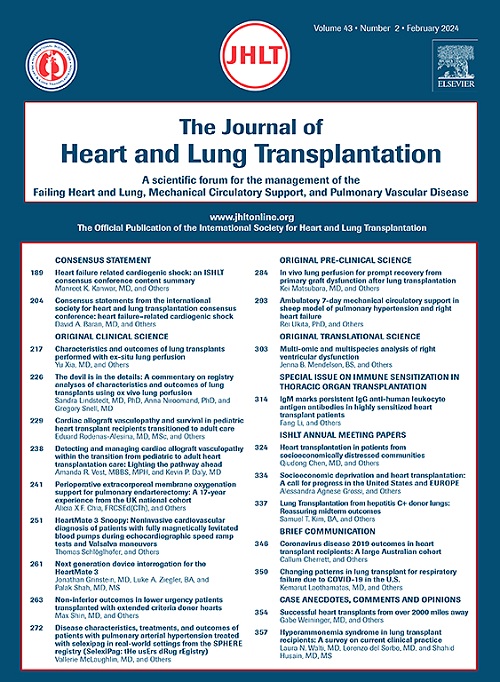是时候重新考虑IABP患者在全球心脏分配系统中的优先次序了?
IF 6
1区 医学
Q1 CARDIAC & CARDIOVASCULAR SYSTEMS
引用次数: 0
摘要
尽管越来越多的证据质疑主动脉内球囊泵(IABP)的有效性和安全性,但它仍被广泛应用于临床实践。作为一种简单的临时机械循环支持装置,IABP可能提供诸如后负荷减少、心输出量增强和冠状动脉灌注改善等益处。然而,IABP-SHOCK II和CRISP MI等大型随机对照试验未能证明急性心肌梗死相关心源性休克的生存获益。ALTSHOCK2研究最近未能显示iabp治疗心力衰竭相关心源性休克患者的临床优势。在国家分配系统优先考虑IABP支持患者的国家,使用IABP作为移植的桥梁尤其普遍。最近的altshock2试验结果对其继续纳入优先级模型的合理性提出了质疑。因此,我们研究了IABP的生理作用,它在休克状态和低心输出量综合征中的应用,以及它在世界范围内移植分配政策中的作用。根据目前的数据,我们呼吁重新评估其在临床实践和移植分配中的作用,以配合强有力的临床证据。本文章由计算机程序翻译,如有差异,请以英文原文为准。
Time to rethink the prioritization of IABP patients in heart allocation systems worldwide?
The intra-aortic balloon pump (IABP) remains widely used in clinical practice despite increasing evidence questioning its efficacy and safety. Designed as a simple temporary mechanical circulatory support device, IABP might offer benefits such as afterload reduction, cardiac output enhancement, and coronary perfusion improvement. However, large randomized controlled trials such as IABP-SHOCK II and CRISP MI have failed to demonstrate a survival benefit in acute myocardial infarction related cardiogenic shock. The ALTSHOCK2 study recently failed to show a clinical advantage of IABP-therapy in patients with heart failure-related cardiogenic shock. The use of IABP as a bridge to transplantation is particularly common in countries where national allocation systems prioritize patients on IABP support. The results of the recent ALTSHOCK2-trial question the justification for its continued inclusion in prioritization models. Hence, we examine the physiological effects of IABP, its application in shock states and low cardiac-output syndrome, and its role in transplantation allocation policies worldwide. In line with the present data, we call for a reevaluation of its role in clinical practice and transplant allocation to align with strong clinical evidence.
求助全文
通过发布文献求助,成功后即可免费获取论文全文。
去求助
来源期刊
CiteScore
10.10
自引率
6.70%
发文量
1667
审稿时长
69 days
期刊介绍:
The Journal of Heart and Lung Transplantation, the official publication of the International Society for Heart and Lung Transplantation, brings readers essential scholarly and timely information in the field of cardio-pulmonary transplantation, mechanical and biological support of the failing heart, advanced lung disease (including pulmonary vascular disease) and cell replacement therapy. Importantly, the journal also serves as a medium of communication of pre-clinical sciences in all these rapidly expanding areas.

 求助内容:
求助内容: 应助结果提醒方式:
应助结果提醒方式:


